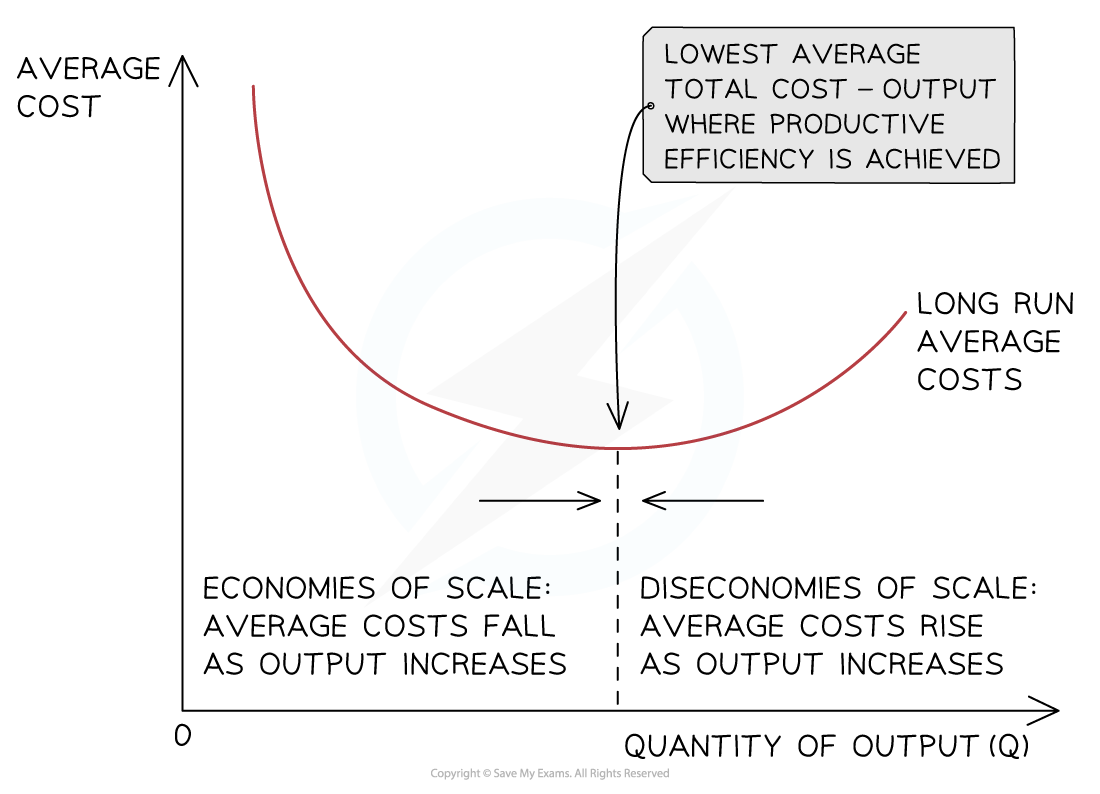Syllabus Edition
First teaching 2025
First exams 2027
Economies & Diseconomies of Scale (Cambridge (CIE) IGCSE Economics): Revision Note
Exam code: 0455 & 0987
An introduction to economies and diseconomies of scale
Economies of scale occur when an increase in the scale of output results in a lower cost per unit
As a firm grows, it is able to increases its scale of output generating efficiencies that lower its average costs (AC) of production
Economies of scale help large firms to lower their costs of production beyond what small firms are able to achieve
Diseconomies of scale occur when an increase in the scale of output results in a higher cost per unit
As a firm continues increasing its scale of output, it will reach a point where its average costs (AC) will start to increase
The reasons for the increase in the average costs are called diseconomies of scale

Diagram analysis
With relatively low levels of output, the firm's average costs are high
As the firm increases its output, it begins to benefit from economies of scale which lower the average cost per unit
At some level of output, a firm will not be able to reduce costs any further
This point is called productive efficiency
Beyond this level of output, the average cost will begin to rise as a result of diseconomies of scale
Causes of internal economies of scale
Internal economies of scale occur as a result of the growth in the scale of production within the firm
Type of economy | Explanation |
|---|---|
Financial economies |
|
Managerial economies |
|
Marketing economies |
|
Purchasing economies |
|
Technical economies |
|
Risk-bearing economies |
|
Causes of diseconomies of scale
As a firm continues to increase its scale of output in the long-run, at some point its average costs will start to increase
The reasons for the increase are called diseconomies of scale
Causes of diseconomies of scale
Type of diseconomy | Explanation |
|---|---|
Management diseconomies |
|
Communication diseconomies |
|
Geographical diseconomies |
|
Cultural diseconomies |
|
Causes of external economies of scale
External economies of scale occur when there is an increase in the size of the industry in which the firm operates
The firm is able to benefit from lower average total costs generated by factors outside of the firm
Sources of external economies of scale
Type of external economy | Explanation |
|---|---|
Geographic cluster |
|
Transport links |
|
Skilled labour |
|
Favourable legislation |
|
Case Study
Discovery Channel in Mediapolis, Singapore
Discovery Channel, a major global broadcaster, has established regional production and broadcasting facilities within Mediapolis, Singapore’s purpose-built media and tech hub. This location provides an excellent example of how external economies of scale benefit large firms as the industry around them expands.

Geographic cluster
As Mediapolis has grown, ancillary firms offering services like animation, sound design, post-production, and media technology support have moved close to large media clients like Discovery
This concentration of supporting firms lowers Discovery’s average costs by reducing travel time, enabling faster collaboration, and giving access to multiple suppliers in one location
Transport links
The development of high-quality transport infrastructure in and around Mediapolis helps Discovery staff and equipment move efficiently across the city and region
With easy access to metro stations, shuttle buses, and expressways, this reduces logistical costs and improves the reliability of production schedules
Skilled labour
Singapore’s government has partnered with universities and polytechnics to ensure a constant supply of skilled media professionals, including editors, producers, and broadcast engineers
Discovery Channel benefits directly from this pool of talent, lowering its recruitment costs and ensuring access to workers with industry-specific expertise
Favourable legislation
Singapore government pro-media policies, including grants, tax relief, and co-investment schemes, have made it more cost-effective for companies like Discovery to operate in the region
This government support helps reduce overheads and encourages long-term investment in innovation and digital production
Summary
Discovery Channel’s presence in Singapore’s Mediapolis illustrates how firms can benefit from external economies of scale driven by growth in the wider media industry

Unlock more, it's free!
Did this page help you?